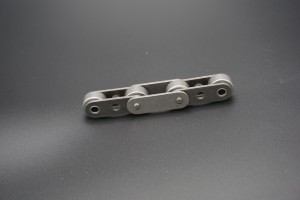Roller chains are an important component in many industrial and mechanical applications. They are used to transmit power and motion between rotating shafts, making them an important part of a variety of machinery and equipment. Understanding the different parts of a roller chain is important to ensure its proper operation and maintenance. In this article, we will explore the five main parts of a roller chain and their significance in the overall operation of this important mechanical component.
Inner link: The inner link is one of the main components of the roller chain. It consists of two inner plates, a bushing and a roller. The inner plates are flat pieces of metal connected by bushings, which serve as the bearing surfaces for the rollers. Rollers, usually made of steel, rotate on bushings and mesh with sprocket teeth to transmit motion and power. The inner link is responsible for keeping the chain aligned and engaged with the sprocket, ensuring smooth and efficient power transmission.
Outer link: The outer link is another important component of the roller chain. It consists of two outer plates, a pin and a roller. The outer plate is similar to the inner plate but is usually shaped differently to accommodate the pins. The pin serves as the pivot point for the inner and outer links, allowing them to articulate and bend around the sprocket. Rollers on the outer links mesh with the sprocket teeth, allowing the chain to transmit motion and power. The outer links play a vital role in maintaining the integrity and flexibility of the roller chain, allowing it to adapt to varying distances between sprockets and adapt to different operating conditions.
Bushing: The bushing is a key component of the roller chain and serves as the bearing surface of the roller. It is typically made from durable materials such as bronze or steel and is designed to withstand the high loads and stresses experienced during operation. The bushings provide a smooth, low-friction surface for the rollers to rotate, reducing wear and extending the life of the chain. Proper lubrication of bushings is critical to ensure smooth operation and prevent premature wear and failure of the roller chain.
Roller: Roller is a key component of the roller chain, responsible for meshing with the sprocket teeth and transmitting motion and power. It is usually made of hardened steel to withstand the high contact pressure and wear during operation. The rollers rotate on the bushings, allowing the chain to mesh smoothly with the sprockets and transmit power efficiently. Proper lubrication of rollers is essential to reduce friction and wear, ensuring smooth operation and service life of roller chains.
Pin: The pin is an important component of the roller chain and is the pivot point of the inner and outer links. It is usually press-fitted into the outer panel and is designed to withstand the bending and articulation forces experienced during operation. Pins play a vital role in maintaining the integrity and flexibility of roller chains, allowing them to accommodate varying distances between sprockets and adapt to different operating conditions. Proper lubrication of the pins is critical to reducing friction and wear, ensuring smooth articulation and longevity of the roller chain.
In summary, roller chains are an essential component in many industrial and mechanical applications, providing a reliable and efficient means of transmitting power and motion. Understanding the five main components of a roller chain (inner links, outer links, bushings, rollers and pins) is critical to ensuring the proper operation and maintenance of this important mechanical component. By paying attention to these critical components and ensuring proper lubrication and maintenance, roller chains can provide reliable, efficient power transmission for a wide range of industrial and machinery applications.
Post time: Jun-14-2024

